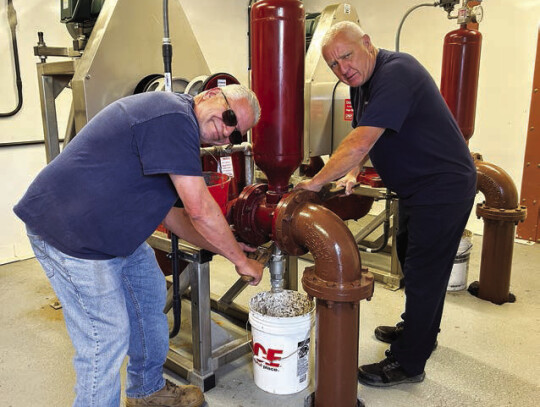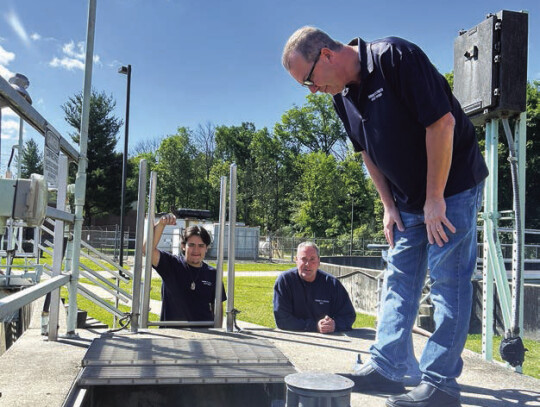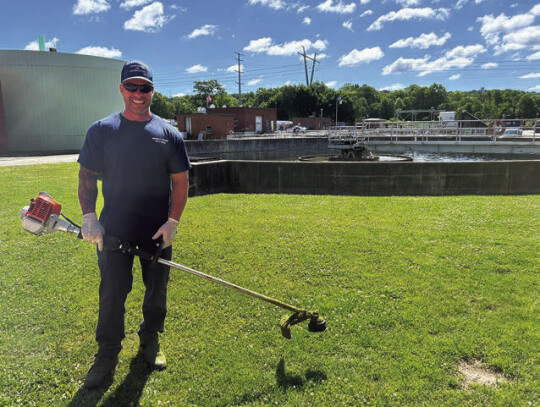The following article about the history and workings of the town’s sewerage treatment plant - known formally as the Water Pollution Control Facility - was submitted by the Livingston Township administration.
••• Clean water is one of the most precious resources on the planet. Ensuring that Livingston’s wastewater is clean is a serious responsibility.
“Most residents don’t really think about Livingston’s Water Pollution Control Facility,” stated WPCF assistant superintendent Kevin Lynn. “The Livingston Water Pollution Control Facility can process up to 4.62 million gallons of water per day, includes more than 140 miles of pipeline, nearly 4,000 manholes and seven lift stations, runs 24 hours each day, 365 days a year, and is operated and maintained by just 11 people.
“The Livingston WPCF is responsible for treating the town’s wastewater before releasing the water back into the Passaic River. Once the water has been treated, it’s actually cleaner than the river water it’s being released into. The fact that all of our treated water is of such a high quality helps improve the overall quality of the Passaic River and the local environment.”
The WPCF serves the entire 13.9 square miles of the township, with the exception of three small areas that are served by other facilities.
A History of Upgrades
Since its creation in 1938, the WPCF has been expanded and upgraded multiple times, ultimately increasing size to its current 12 buildings, and increasing its capacity from three million gallons per day (MGD) to 4.2 MGD. To put this in perspective, 4.2 MGD would fill 6.36 Olympic-size swimming pools with the amount of wastewater the Township treats daily. All of this flows into the WPCF through the 140 miles of pipeline, nearly 4,000 manholes and 7 lift stations that make up the town’s sewer collection.
Significant Modernization
1987: New tanks for settling and aeration were added in order to increase the WPCF capacity. These tanks help remove solids and add oxygen to the wastewater to promote the growth of beneficial biological microorganisms. Additional screening was put in place at the start of the treatment plant to remove larger materials and protect the downstream equipment. The existing sludge digestion facilities were overhauled to allow additional storage, dewatering, and stabilization before final offsite disposal. All of these improvements combined allowed the Township to increase filtration and treatment of water.
1993: Significant plant upgrades were made at a construction cost of approximately $17,300,000. Upgrades were primarily provided for the following processes: Nitrification: removes ammonia, which is toxic to many fish, from the water; Effluent polishing: improves the quality of effluent - the cleaned water being discharged into a river or sea - by using filters to remove any solids left in the water; Sludge thickening: increases the solids concentration of wastewater and decreases the amount of free water, which helps to reduce the amount of water being wasted in the overall cleaning process; the leftover sludge (called biosolids) is disposed of by landfilling, incineration, or recycling to the soil as fertilizer; and Dechlorination: Removes any remaining chlorine from disinfected wastewater before the water is returned to the environment.
Recent Investments and Improvements
“Since 2018,” continued Lynn, “we’ve made even more investments in and improvements to the facility to make sure we’re doing the best possible job for our residents.”
Over the past six years, additional improvements to the WPCF have included:
• Installing 20 new motors throughout the plant. These motors cost approximately $10,000 each and are critical for powering the equipment in every building and pump station.
• Installing a new seal water system to improve the reliability of pumping operations.
• Installing one new primary pump station at the plant. This included replacing sludge pumps, installing new control panels, and constructing a new building to house the pump station, and cost approximately $750,000.
• Installing two new polymer tanks to store water. These tanks allow the polymer to mix with the water in order to help remove additional water from the sludge to create larger solids. This work was completed internally, including the tank, mixers and plumbing.
• Rehabilitating two of the town’s seven pump stations (also called lift stations), with improvements to one more scheduled later this year. These stations are located outside the WPCF facility and are used to “lift” or pump wastewater when it can’t be moved using basic gravity sewers. This work includes what is essentially a complete overhaul of existing equipment and replacing pumps, check valves, gaskets, fencing, and grinders. Some of the work has been done in house and some by outside contractors.
• Replacing 22 pumps throughout the plant. Pumps are critical for moving wastewater from tank to tank and are used at various different stages of treatment.
• Replacing 55 of the old valves controlling the flow of water inside pipes throughout the WPCF. As valves age they can become corroded and brittle, making it impossible to turn them in order to complete necessary tasks. These were replaced at a cost of $200,000.
• Replacing one of the facility’s three disc filters, with the other two scheduled and funded for replacement later this year. Disc filters help filter contaminants from water and are used in one of the final stages of water treatment to “polish” the effluent and remove any remaining particles. The screens being replaced were part of the 1993 plant upgrades, which had become obsolete, and difficult and expensive to repair some time ago.
• Rehabilitating WPCF buildings and equipment. Replacing 11 building roofs, with one more scheduled for later this year. Since all had originally been installed at similar times, they all were in need of replacement due to extensive wear and leaks.
• Replacing 13 of 16 exhaust fans. Exhaust fans are crucial in expelling any sewage odors or other by-products emitted from the WPCF. Several were replaced when the building roofs were replaced.
• Painting four building interiors. “As you can imagine,” continued Lynn, “there’s a great deal of work that goes into maintaining and upgrading facility infrastructure. Our dedicated team of employees are not only responsible for the facility seven days a week, 365 days a year – they’re always on call to respond in person to after-hours emergencies whenever they’re needed.”
Thanks to the continued capital investments funded by the members of the Livingston Township Council, the WPCF staff of 11 has been able to reduce equipment downtime, streamline operations, and decrease the number of sewer backups while making a positive impact on the environment.
To learn more about Livingston’s Water Pollution Control Facility and the Sewer Utility, go to livingstonnj. org/Sewer.





